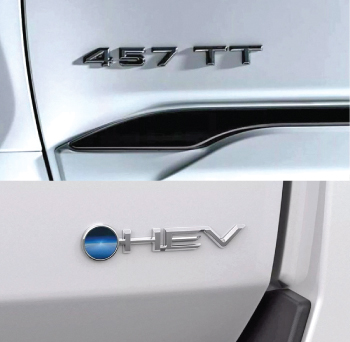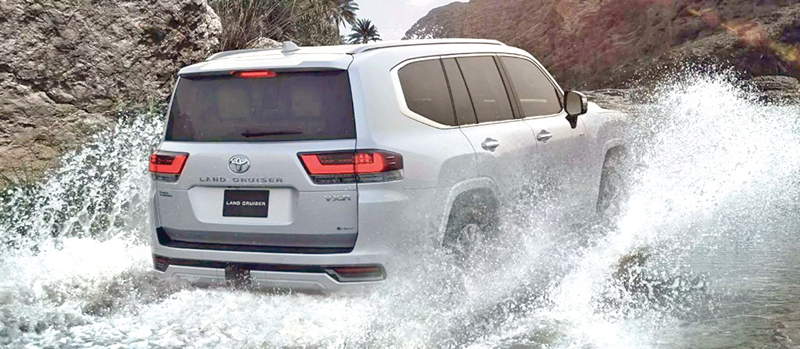 The all-new version of the Toyota Landcruiser LC300 Series is now ubiquitous on Sri Lankan roads after the car import ban was lifted, along with the smaller sibling the LC 250, also called Prado in some markets. Buyers have opted for both petrol and diesel powertrains of the LC300, even though the diesel version has a higher sticker price due to the duty structure.
The all-new version of the Toyota Landcruiser LC300 Series is now ubiquitous on Sri Lankan roads after the car import ban was lifted, along with the smaller sibling the LC 250, also called Prado in some markets. Buyers have opted for both petrol and diesel powertrains of the LC300, even though the diesel version has a higher sticker price due to the duty structure.
However, Toyota’s “big daddy” did not have a hybrid version until now. This was surprising, given that Toyota is a hybrid pioneer and its Prius has been on sale for nearly 30 years. But that honour instead went to Toyota’s luxury arm Lexus, with its LX 700h version which is built on the same TNGA-F (Toyota New Global Architecture) platform.
Its less powerful version, the 600, can also be seen on our roads, albeit less frequently than the Toyota. It will only be a matter of time before the 700h also reaches our shores.
 For the LC300 hybrid version, Toyota does more than simply tossing a battery pack onto their existing platform but gives the most powerful Land Cruiser configuration ever. At the heart of the new setup is a parallel hybrid system combining a twin-turbo 3.5-litre V6 gasoline (petrol) engine with a single electric motor. The duo puts out a combined 457 hp (341 kW / 464 PS) and 790 Nm (583 lb-ft) of torque, making this the most powerful Land Cruiser to date. Toyota is unlikely to make a diesel hybrid, though.
For the LC300 hybrid version, Toyota does more than simply tossing a battery pack onto their existing platform but gives the most powerful Land Cruiser configuration ever. At the heart of the new setup is a parallel hybrid system combining a twin-turbo 3.5-litre V6 gasoline (petrol) engine with a single electric motor. The duo puts out a combined 457 hp (341 kW / 464 PS) and 790 Nm (583 lb-ft) of torque, making this the most powerful Land Cruiser to date. Toyota is unlikely to make a diesel hybrid, though.
Power is delivered to all four wheels through a 10-speed automatic transmission, the same one found in the 3.3 V6 diesel LC300 which is available in Sri Lanka. Incidentally, the same powertrain configuration is found in the US-market Tundra i-Force Max and Sequoia, though the Land Cruiser delivers slightly more output than the pickup trucks.
Peace of mind on long trips
The hybrid system introduces a 20 percent increase in torque and a 40 percent improvement in accelerator response compared to conventional powertrains, resulting in a driving experience that is more powerful, more linear, and more responsive across every terrain. It is important to note that this is a self-charging hybrid, not a plug-in one.
Seamlessly integrated into the current LC300 platform, the electric motor provides instant torque fill at low RPMs, perfect for navigating hilly terrain or pulling heavier loads. Toyota claims the system delivers “smooth and even throttle response even in the toughest of terrain,” based on extensive testing in Middle Eastern deserts and mountain environments. In fact, the car will be sold first in the Middle East, before reaching Australia and other Right Hand Drive (RHD) markets.
Toyota has engineered the hybrid section for off-road duty, which is where the LC300 anyway excels. The battery area is waterproofed, recognising that real Land Cruiser owners like to take it off-road and even across a bit of water. In the unlikely event of hybrid unit failure, the vehicle can continue operating solely on the combustion engine, ensuring peace of mind in remote areas. There is also a built-in 1,500-watt AC inverter in the cargo area, for powering tools, compressors, or camp gear.
Land Cruiser drivers will appreciate how the hybrid maintains the imposing presence of the original, while adding subtle differentiation. The comfort-oriented VXR trim features an updated front bumper with revised intake design. There will also be a GR Sport variant. Both these trims will have “457 TT” side badges and “HEV” (Hybrid Electric Vehicle) tailgate emblems to mark their electrified status.
Toyota has updated the digital instrument cluster with hybrid-specific graphics, paired with a 12.3-inch infotainment display, the same one found in the normal car. The interior retains the Land Cruiser’s luxury approach with up to seven comfortable seats and ample legroom.
But something had to give and that happens to be the fuel tank. The hybrid has a 68-litre fuel tank versus the standard gasoline model’s 80-litre one, though some fossil-fuel powered Land Cruisers also have a reserve tank of 30 litres. Still, with better fuel consumption than the regular V6, the range should more or less be the same, offering peace of mind to the driver and passengers even on long trips that take in every terrain imaginable.








